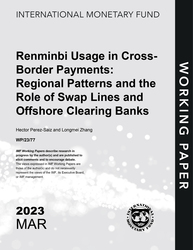
Renminbi Usage in Cross-Border Payments: Regional Patterns and the Role of Swaps Lines and Offshore Clearing Banks
Renminbi Usage in Cross-Border Payments: Regional Patterns and the Role of Swaps Lines and Offshore Clearing Banks
READ MORE...
Volume/Issue:
Volume 2023
Issue 077
Publication date: March 2023
ISBN: 9798400235559
$20.00
Add to Cart by clicking price of the language and format you'd like to purchase
Available Languages and Formats
| English |
Prices in red indicate formats that are not yet available but are forthcoming.
Topics covered in this book
This title contains information about the following subjects.
Click on a subject if you would like to see other titles with the same subjects.
Banks and Banking , Exports and Imports , Economics- Macroeconomics , Money and Monetary Policy , Economics / General , RMB internationalization , Swift , Swap lines , Offshore Clearing Banks , liquidity shortage , RMB payment , renminbi usage , usage of the renminbi , Offshore financial centers , Currencies , Capital account , Reserve currencies , International monetary system , Global
Summary
The paper examines the usage of the Renminbi (RMB) as an international payment currency. Globally, the use of RMB remains small, accounting for 2 percent of total cross-border transactions. Using country-level transaction data from Swift** for 2010–21, we find significant regional variations in the use of RMB for cross-border payments. While RMB is little used in some regions, it has gained traction in others, and these cross-country differences have widened over the years. Such differences can be partly explained by an economy’s geographic distance, political distance, and trade linkages with China. However, it also reflects the impact of policy measures by the People’s Bank of China, including establishing bilateral swap lines and offshore clearing banks. Both policy measures helped to address offshore RMB liquidity shortages given China’s overall capital account restrictions, with the offshore clearing banks having a quantitatively larger impact. Our analysis contributes to a better understanding of the growing importance of RMB within the international monetary system.
Copyright © 2010 - 2025
Powered by:
AIDC



